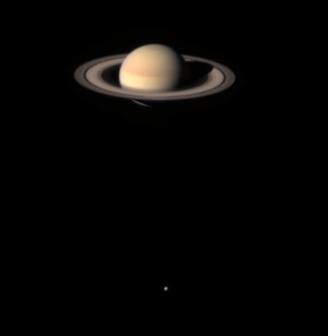|
The Cassini-Huygens mission
|
South up South up  Original image tif 56kB Original image tif 56kB

Original Caption Released with Image:
Saturn appears serene and majestic in the first color composite made of images taken by NASA's Cassini spacecraft on its approach to the ringed planet, with arrival still 20 months away.
The planet was 285 million kilometers (177 million miles) away from the spacecraft, nearly twice the distance between the Sun and Earth, when Cassini took images of it in various filters as an engineering test on Oct. 21, 2002.
It is summer in Saturn's southern hemisphere. The Sun is a lofty 27 degrees below the equator and casts a semi-circular shadow of the planet on the rings. The shadow extends partway across the rings, leaving the outer A ring in sunlight. The last Saturn-bound spacecraft, Voyager 2, arrived in early northern spring. Many features seen in Voyager images -- spoke-like markings on the rings, clouds and eddies in the hazy atmosphere, ring-shepherding moons -- are not yet visible to Cassini.
Titan, Saturn's largest moon, appears in the upper left. It is the only moon resolved from this distance. This composite uses a threefold enhancement in the brightness of Titan relative to the brightness of Saturn. Titan is a major attraction for scientists of the Cassini-Huygens mission. They will study its haze-enshrouded atmosphere and peer down, with special instrumentation, to its surface to look for evidence of organic processes similar to those that might have occurred on the early Earth, prior to the emergence of life.
Cassini will enter orbit around Saturn on July 1, 2004. It will release a piggybacked probe, Huygens, which will descend through Titan's atmosphere on Jan. 14, 2005.
The Cassini-Huygens mission is a cooperative project of NASA, the European Space Agency and the Italian Space Agency. Information about the mission is available online at http://saturn.jpl.nasa.gov . The Jet Propulsion Laboratory, a division of the California Institute of Technology in Pasadena, manages the mission for NASA's Office of Space Science, Washington, D.C.
Image Credit:
NASA/JPL/Southwest Research Institute
[NASA/JPL/Space Science Institute]
 ALPO-Japan Latest ALPO-Japan Latest  Saturn Section Saturn Section
|
 D. A. Peach, Puerto de la Cruz, Tenerife, Canary Isl.
11" (28 cm) Celestron SCT @ f/31.4. SBIG ST-5c camera.
SBIG RGB Filter set.
Total Exposure Times:
Integrated Light: 80 x 0.36 secs
Red Light: 10 x 0.60 secs
Green Light: 10 x 0.60 secs
Blue Light: 10 x 0.70secs
Seeing poor-fair (3-5.) - Immediate post cold front.
Transparency excellent (5.5mag+).
Wind ENE (0-5mph.) Moderate dew.
Equatorial Diam= 19.4"
Altitude=82 degs.
--------------------------------------------------------------
Hi all,
Here are some Saturn images from this morning. Seeing was pretty turbulent immediately f. a cold front. The green colouration can be noted
across the southern hemisphere.
This is also the longitude of Ed's spot, but seeing wasnt good enough to verify its presence.
Best Wishes
Damian
[Rochester, Kent, UK.]
≪ダミアン ピーチ イギリス≫
D. A. Peach, Puerto de la Cruz, Tenerife, Canary Isl.
11" (28 cm) Celestron SCT @ f/31.4. SBIG ST-5c camera.
SBIG RGB Filter set.
Total Exposure Times:
Integrated Light: 80 x 0.36 secs
Red Light: 10 x 0.60 secs
Green Light: 10 x 0.60 secs
Blue Light: 10 x 0.70secs
Seeing poor-fair (3-5.) - Immediate post cold front.
Transparency excellent (5.5mag+).
Wind ENE (0-5mph.) Moderate dew.
Equatorial Diam= 19.4"
Altitude=82 degs.
--------------------------------------------------------------
Hi all,
Here are some Saturn images from this morning. Seeing was pretty turbulent immediately f. a cold front. The green colouration can be noted
across the southern hemisphere.
This is also the longitude of Ed's spot, but seeing wasnt good enough to verify its presence.
Best Wishes
Damian
[Rochester, Kent, UK.]
≪ダミアン ピーチ イギリス≫ Original image tif 56kB
Original image tif 56kB 
 ALPO-Japan Latest
ALPO-Japan Latest